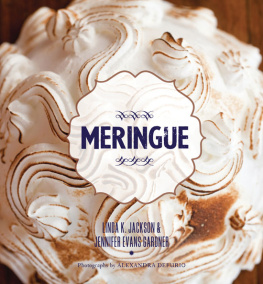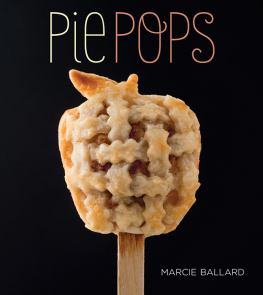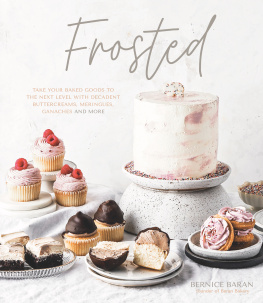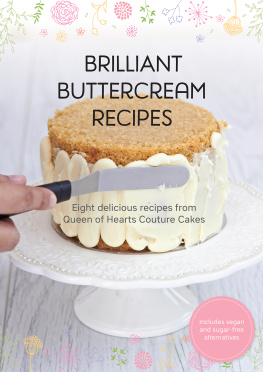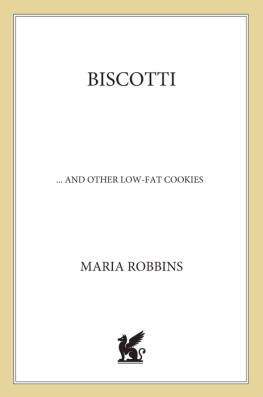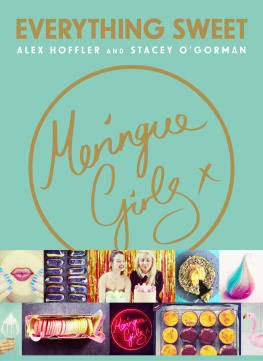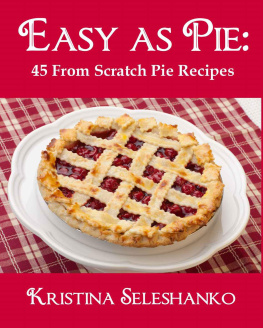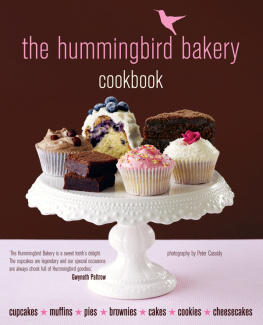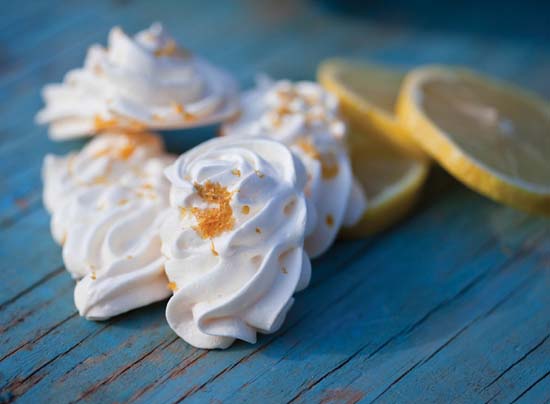Meringue
Linda K. Jackson & Jennifer Evans Gardner
Photographs by Alexandra DeFurio

Meringue
Digital Edition 1.0
Text 2012 Linda K. Jackson & Jennifer Evans Gardner
Photographs 2012 Alexandra DeFurio
All rights reserved. No part of this book may be reproduced by any means whatsoever without written permission from the publisher, except brief portions quoted for purpose of review.
Gibbs Smith
P.O. Box 667
Layton, Utah 84041
Orders: 1.800.835.4993
www.gibbs-smith.com
ISBN: 978-1-4236-2582-7
For Chris, Hannah, and Adam, who make my life so sweet. LKJ
To my Grammy Olga, who is surely baking meringue for the angels right now, and to Kellen, whose smile I would take over dessert any day. JEG
Acknowledgments
We would like to thank our families and friends for their love and encouragement, and for so selflessly offering to taste our creations during recipe development. Most of all, thanks to Paul, Arianne, Cleo, Henry, Oliver, Dawn, Pete, Laura, Ezekiel, Papo, Mike, Alex, Cyndi, Mark, Pha, June, Jessica, Victoria, and Owen.
Special thanks to our fantastic editor (and fellow brown sugar thief) Michelle Branson and the entire Gibbs Smith team; the brilliant Alexandra DeFurio and Anni Daulter for creating the most gorgeous meringue photos ever; Karen Kaplan for her generous suggestions and Steven Krakowsky for his wise counsel; our agent Deborah Ritchken for being the first to fall in love with our meringue cookbook and for finding it a home; the Neighborhood School for bringing us together lo so many years ago, and finally, our mothers Dolores and Dorothy, who still make the best lemon meringue pies weve ever tasted.
Introduction
Egg whites. Sugar. A pinch of cream of tartar or a dash of vinegar. And air.
Meringue. How can something be so simple, so divine, and yet so intimidating at the same time?
We both fell in love with meringue the same way. Though we grew up thousands of miles apart, it was the first bite of our mothers lemon meringue pies, the fluffy topping still warm from the oven atop sweet lemon curd that made us swoon. But it was years before we fully realized how many different forms meringue could takeand we were hooked for life. For Linda, it was the addictive meringue gelato at the world famous gelateria Vivoli in Florence; for Jennifer, it was a cloud-light meringue torte, le Vacherin, while living in Paris.
Our paths finally merged at a potluck feast at our childrens preschool. We spotted the desserts firstLindas tiny, light-as-a-cloud meringue cookies flecked with chocolate and Jennifers raspberry meringue tartletsamidst the store-bought cakes, cookies, and one sad frozen lasagna. As the adults elbowed their toddlers out of the way to get to our desserts, our eyes met, smiles in check. It was friendship at first sight.
We always get the same reaction when we serve meringues. It seems that because they are so delicate and look so elegant, everyoneeven our friends who are experienced bakersassumes they are difficult to make. Not so. They may look intimidating, but they are actually quite simple to make. Even those with little or no baking experience can quickly master meringue.
Meringue is magical. It is incredibly versatile. It can be spooned onto pies, or piped into any number of beautiful shapes. It can be baked or poached, whipped into silky frostings, or folded into cakes to make them fluffier. It can be combined with ground nuts, chocolate, or any number of flavorings. It can be formed into various vessels for chantilly cream and fresh berries. And thats just the beginning. We hope this book will encourage you to embrace meringue as we have, and that it inspires you to make heavenly creations of your very own.
About Meringue
A Bit of History
Meringue isnt just magical. Its mysterious. No one can quite agree on its origins (and heres a hint: it wasnt invented in France). According to the Larousse Gastronomique: The New American Edition of the Worlds Greatest Culinary Encyclopedia:
Some historians of cookery believe that the meringue was invented by a Swiss pastry cook called Gasparini, who practiced his art in the small town of Meiringen (now in East Germany). Others maintain that the word comes from the Polish word marzynka and that the preparation was invented by a chef in the service of King Stanislas I Leszcynski, who later became Duke of Lorraine. The king passed on the recipe to his daughter, Marie, who introduced it to the French. Queen Marie Antoinette had a great liking for meringues and court lore has it that she made them with her own hands at the Trianon, where she is also said to have made vacherins, which are prepared from a similar mixture.
While most food historians confirm Marie Antoinettes love of meringues, some say that meringue goes back to a much earlier date...and that it was invented in England, of all places. The earliest documented recipe for a baked beaten-egg-white-and-sugar confection is the handwritten recipe for White Bisket Bread by Lady Elinor Fettiplace in 1604 in Oxfordshire, which later appeared in the cookbook Elinor Fettiplaces Receipt Book Elizabethan Country House Cooking.
Historians do agree on this: Until the early nineteenth century, meringues cooked in the oven were shaped with a spoon. It was the great French pastry chef Antoine Carme who first used a piping (pastry) bag.
We know one thing for certain: meringue is deceptively simple, and once you know the basics, you can create sweet magic with meringue cookies, Pavlovas, pies, tartseven marjolaines and dacquoises.
And Some Science...
But first, a note about that magicor the scienceof meringue. Exactly how do egg whites turn into voluminous cloud-like confections, anyway? In simple laymens terms (as we arent scientists), beating an egg white causes the proteins to unfold, after which it recombines into a new structure around air bubbles, creating volume.
Adding acid, such as cream of tartar or vinegar, slows coagulation so that more air can be added, and the whipped egg whites can expand to as much as eight times their original volume.
Adding sugar helps stabilize the beaten egg whites and helps them hold their shape. In the meantime, sugar pulls the water from the egg whites, allowing them to set up better.
When meringues are cooked or baked, the steam created by the heat causes the air bubbles to expand even more, creating greater volume.
The Three Stages of Meringue
Whether whisking by hand or with an electric mixer, egg whites go through various stages to become meringue: Foamy, soft peaks, and stiff peaks. Some cookbooks also reference medium peaks, however, as the stage just before stiff peaks is so subtle in its difference, we found that it wasnt relevant.
Foamy
The egg whites will still be a liquid, they may have a cloudy yellow color, and large bubbles will have formed.
Soft peaks
The egg whites will become snowy white, and as your whisk moves through the meringue, youll see ribbons or lines from the wires of the whisk. At this point, with the mixer running, you will slowly begin to add sugar, about 1 tablespoon at a time. When you pull your whisk up from the bowl, a peak will form but wont hold its shape for long.

